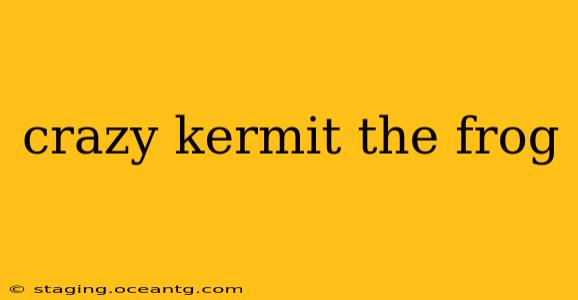Kermit the Frog, the iconic Muppet, has transcended his role as a lovable, albeit sometimes exasperated, puppeteer creation. He's become a memetic powerhouse, particularly with the "Crazy Kermit" meme. This image, usually featuring Kermit battling his inner desires, has resonated with millions, tapping into relatable experiences of internal conflict and temptation. But what exactly makes this meme so popular, and what does it mean? Let's dive into the surprisingly complex world of Crazy Kermit.
What is the Crazy Kermit Meme?
The Crazy Kermit meme typically depicts two versions of Kermit: one, the sensible, rational Kermit we know and love, and the other, a wild, impulsive, "crazy" Kermit. This "crazy" Kermit usually represents desires or actions that the sensible Kermit would typically avoid. The meme's format often presents a caption suggesting a tempting, yet possibly unwise, activity (the "crazy" Kermit's desire) contrasted with the more responsible alternative (the sensible Kermit's response). The juxtaposition highlights the internal struggle we all experience between our better judgment and our less-than-savory impulses.
Why is the Crazy Kermit Meme So Popular?
The Crazy Kermit meme's widespread popularity stems from its relatability. We've all been there – battling the urge to indulge in something we know isn't good for us, whether it's staying up late, eating an entire cake, or procrastinating on an important task. The meme brilliantly captures this internal struggle in a humorous and easily digestible format. The familiar face of Kermit, combined with the simple yet effective visual representation of internal conflict, makes the meme instantly understandable and universally appealing.
What Does Crazy Kermit Represent?
At its core, the Crazy Kermit meme represents the internal conflict between our rational selves and our desires. It's a playful acknowledgment of the human condition – the constant battle between self-control and temptation. It's a meme that allows people to laugh at their own flaws and imperfections while simultaneously validating the universal experience of inner conflict. It speaks to a shared human experience, making it incredibly relatable and memorable.
How Did the Crazy Kermit Meme Originate?
While pinpointing the exact origin of the meme is difficult, it gained traction on social media platforms like Tumblr and Twitter around the mid-2010s. The meme's simplicity and widespread relatability quickly propelled it into widespread usage, becoming a staple of internet humor. The specific image used varies, but the core concept – the contrast between sensible and impulsive Kermit – remains consistent.
Is Crazy Kermit a Positive or Negative Meme?
The Crazy Kermit meme isn't inherently positive or negative. It's a reflection of a common human experience, presented in a humorous and lighthearted way. While it might be used to justify impulsive behavior, it more often serves as a self-deprecating joke, a way to acknowledge our own flaws and share a laugh about our internal struggles. The meme's ultimate message is one of relatable imperfection, highlighting the shared human experience of internal conflict.
How is Crazy Kermit Used in Social Media?
The meme's versatility allows for countless interpretations and applications. Users create variations featuring different scenarios, from simple everyday temptations to more significant life choices. This adaptability ensures the meme remains fresh and relevant, continually generating new and engaging content across various social media platforms. The flexibility of the meme allows for both personal and topical usage, adding to its enduring popularity.
What are other similar memes to Crazy Kermit?
Several memes tap into a similar vein of internal conflict, such as "Distracted Boyfriend" and various "Me vs. Myself" formats. However, Crazy Kermit's unique use of a beloved character and its simple yet impactful visual representation make it particularly memorable and widely shared. The familiarity of Kermit contributes significantly to the meme's impact and resonance.
In conclusion, the Crazy Kermit meme's success lies in its relatable portrayal of the human condition: the ongoing struggle between reason and desire. Its simple design, coupled with its universal appeal, has solidified its place in internet culture as a testament to the enduring power of humor and self-awareness.
